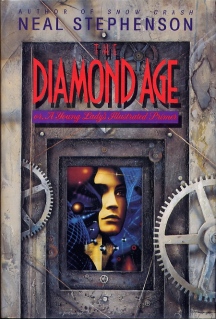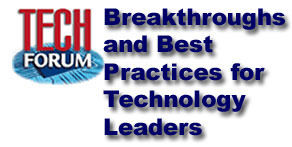 I’ve been holding out on this one, because I still do not have my mind wrapped around it. But because of an article I ran across in Digg yesterday, I decided it was time to let loose. I am reading a book right now, one that was recommended to me by Doug Johnson. The book, called The Diamond Age, by Neal Stephenson (author of Snow Crash, Cryptonomicon, and other cyberpunk works) also sports a subtitle, a Young Lady’s Illustrated Primer — Doug suggested the book during a discussion of digital textbooks.
I’ve been holding out on this one, because I still do not have my mind wrapped around it. But because of an article I ran across in Digg yesterday, I decided it was time to let loose. I am reading a book right now, one that was recommended to me by Doug Johnson. The book, called The Diamond Age, by Neal Stephenson (author of Snow Crash, Cryptonomicon, and other cyberpunk works) also sports a subtitle, a Young Lady’s Illustrated Primer — Doug suggested the book during a discussion of digital textbooks.
Near future engineers (living in a retro-victorian culture), have invented a book to provide an education for privileged children, that circumvents the prevailing education system of their time — evidently not that much has changed in the classroom.
Nell, a disadvantaged girl in the story, has surreptitiously gained access to one of the primer books. Here is an excerpt from Diamond Age, Nell’s first experience with her primer.
The book spoke in a lovely contralto, with an accent like the very finest Vickys. The voice was like a real person’s though not like anyone Nell had ever met. It rose and fell like slow surf on a warm beach, and when Nell closed her eyes, it swept her out into an ocean of feelings.
Once upon a time there was a little Princess named Nell who was imprisoned in a tall dark castle on an island in the middle of a giant sea, with a little boy named Harv, who was her friend and protector. She also had four special friends named Dinosaur, Duck, Peter Rabbit, and Purple.
Princess Nell and Harv could not leave the Dark Castle, but from time to time a raven would come to visit them.
“What’s a raven?” Nell said
The illustration was a colorful painting of the island seen from up in the sky. The island rotated downward and out of the picture, becoming a view toward the ocean horizon. In the middle was a black dot. The pictute zoomed in on the black dot, and it turned out to be a bird. Big letters appeared beneath. “R A V E N,” the book said. “Raven. now, say it with me.”
“Raven.”
“Very good! Nell, you are a clever girl, and you have much talent with words. Can you spell raven?”
Nell hesitated. She was still blushing from the praise. After a few seconds, the first of the letters began to blink. Nell prodded it.
The letter grew until it had pushed all the other letters and pictures off the edges of the page. The loop on top shrank and became a head, while the lines sticking out the bottom developed into legs and began to scissor. “R is for Run,” the book said. The picture kept on changing until it was a picture of Nell. Then something fuzzy and red appeared beneath her feet. “Nell Runs on the Red Rug,” the book said, and as it spoke, new words appeared.
“Why is she running?”
“Because an Angry Alligator Appeared,” the book said, and panned back qulte some distance to show an alligator, waddling along ridiculously, no threat to the fleet Nell. The alligator became frustrated and curled itself into a circle, which became a small letter. “A is for Alligator. The Very Vast alligator Vainly Viewed Nell’s Valiant Velocity” 1
The book is an interactive (n), not a tutorial. The progression to reading is not pre-packaged. Instead, it interacts with the reader, generating learning experiences within the telling of the story, one involving the reader. The fact of the matter is that we are not far from computer technology that is this powerful, and the precedent is certainly there, that the hottest personal computer technology goes to the kids. Well, not for education, but for game-playing. But that’s another issue.
Yesterday, I took a precious ten minutes at the end of the workday (4:30 AM – 7:00PM) to scan through some Digg articles. I ran across one referring to this Associated Press story, E-Tutoring Broadens Bounds of Outsourcing. I’d heard of this going on, but this article (Oct 22) was the first published report. Here is an excerpt:
COCHIN, India – A few stars are still twinkling in the inky pre-dawn sky when Koyampurath Namitha arrives for work in a quiet suburb of this south Indian city. It’s barely 4:30 a.m. when she grabs a cup of coffee and joins more than two dozen colleagues, each settling into a cubicle with a computer and earphones.
More than 7,000 miles away, in Glenview, Ill., outside Chicago, it’s the evening of the previous day and 14-year-old Princeton John sits at his computer, barefoot and ready for his hourlong geometry lesson. The high school freshman puts on a headset with a microphone and clicks on computer software that will link him through the Internet to his tutor, Namitha, many time zones away.
It’s called e-tutoring  yet another example of how modern communications, and an abundance of educated, low-wage Asians, are broadening the boundaries of outsourcing and working their way into the minutiae of American life, from replacing your lost credit card through reading your CAT scan to helping you revive your crashed computer.2
I bring these two items to your attention to suggest that education in the (near) future may be more radically different than my romantic notions of the classroom have allowed. Is it possible that a fully interactive book could teach children to read and perform mathematics. Is it possible that tutoring of advanced math and science across a dozen time-zones might be more effective than a teacher in a classroom of 30?
My answer to that question is, “Yes, it may be!” I was born and educated during the industrial age and I have very romantic notions about how things should be, and the question that this leaves me with is, “What can we do in teacher-lead classrooms, that can’t be done by interactive books and nearly seamless telecommunication. What should children be learning that they can only learn in a group lead by a teacher?
What do you think?
——————————–
Digg — (http://digg.com/) Digg is an intriguing online newspaper where readers suggest stories and the stories are rated by readers. The stories with the most votes, or Diggs, surface to the top of the list. In other words, the headlines are determined not by an editorial staff, but by the readers.
1 Stephenson, Neal. The Diamond Age: Or, a Young Lady’s Illustrated Primer. New York: Bantam Books, 1995.
2 George, mirmala, Martha Irvine. “e-Tutoring Broadens Bounds of Outsourcing.” Yahoo! News 22 Oct 2005. 26 Oct 2005 <http://news.yahoo.com/s/ap/20051022/ap_on_hi_te/tutored_from_afar_1>
 It’s been a while since I’ve talked about Blogmeister, so I thought I’d just mention some statistics. There are currently almost 1500 teachers using blogmeister, managing more than 11,500 student accounts. There are users in 46 states of the U.S. and 37 countries. So far, more than 22,000 articles have been posted by teachers and students.
It’s been a while since I’ve talked about Blogmeister, so I thought I’d just mention some statistics. There are currently almost 1500 teachers using blogmeister, managing more than 11,500 student accounts. There are users in 46 states of the U.S. and 37 countries. So far, more than 22,000 articles have been posted by teachers and students.
 Perhaps one of the best small conferences around is Technology & Learning’s
Perhaps one of the best small conferences around is Technology & Learning’s  Will Richardson has been sharing his experiences in the Monterey area of California, where he was speaking at the
Will Richardson has been sharing his experiences in the Monterey area of California, where he was speaking at the  I’ve been holding out on this one, because I still do not have my mind wrapped around it. But because of an article I ran across in Digg yesterday, I decided it was time to let loose. I am reading a book right now, one that was recommended to me by Doug Johnson. The book, called
I’ve been holding out on this one, because I still do not have my mind wrapped around it. But because of an article I ran across in Digg yesterday, I decided it was time to let loose. I am reading a book right now, one that was recommended to me by Doug Johnson. The book, called  A couple of weeks ago, I worked a conference in another state. I was fortunate enough to have the time to explore the exhibitors and to attend a number of presentations by some very innovative teachers.
A couple of weeks ago, I worked a conference in another state. I was fortunate enough to have the time to explore the exhibitors and to attend a number of presentations by some very innovative teachers.